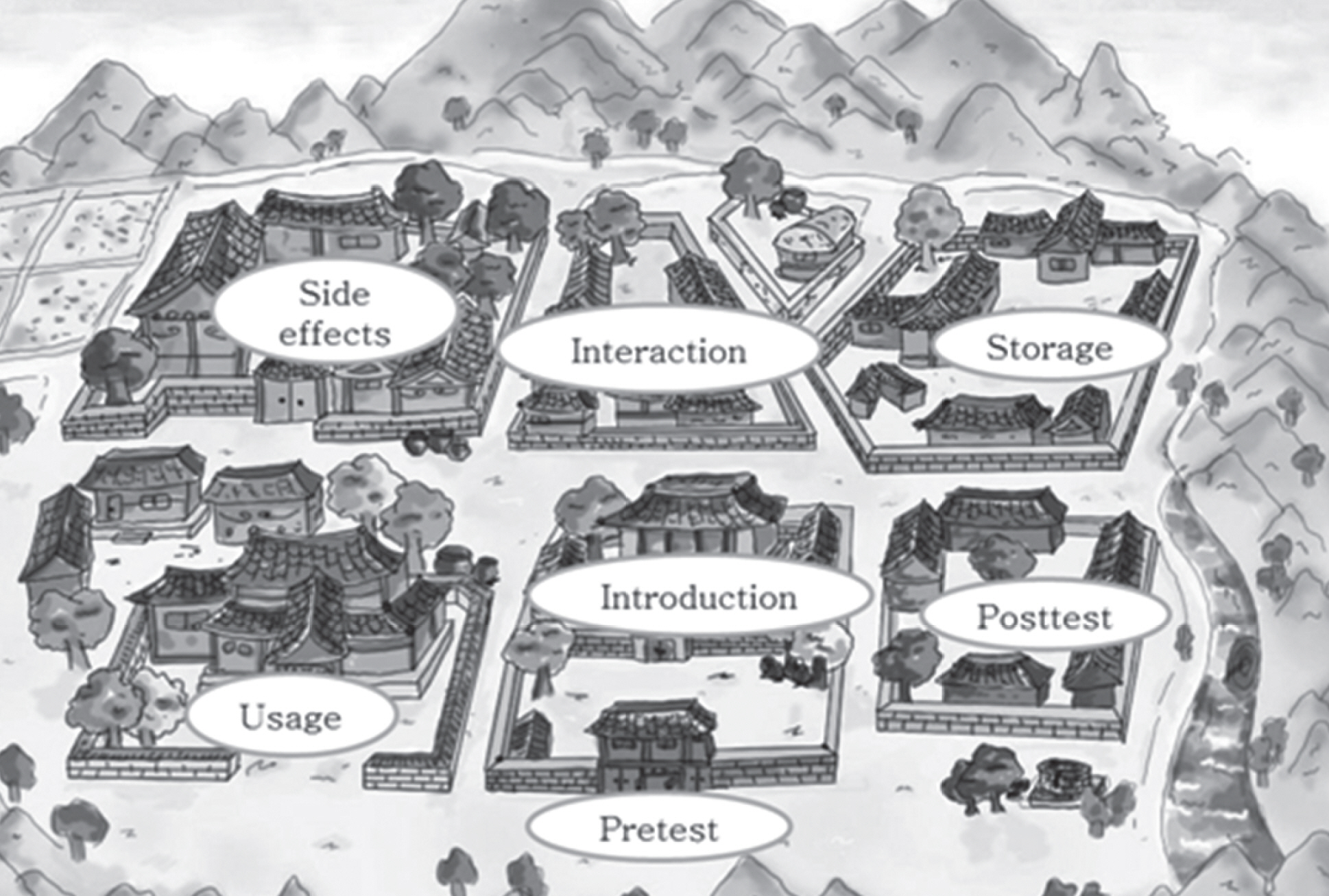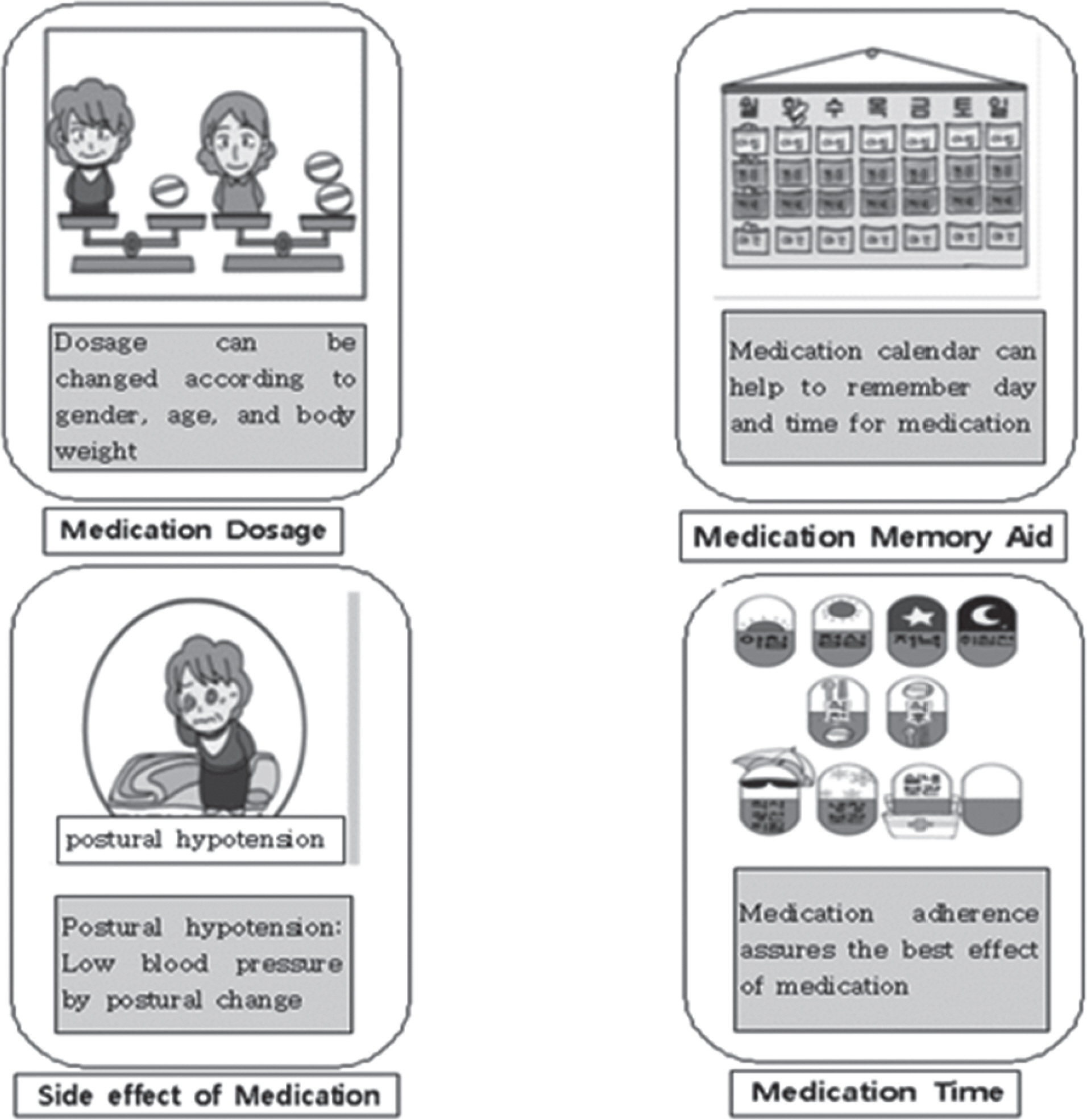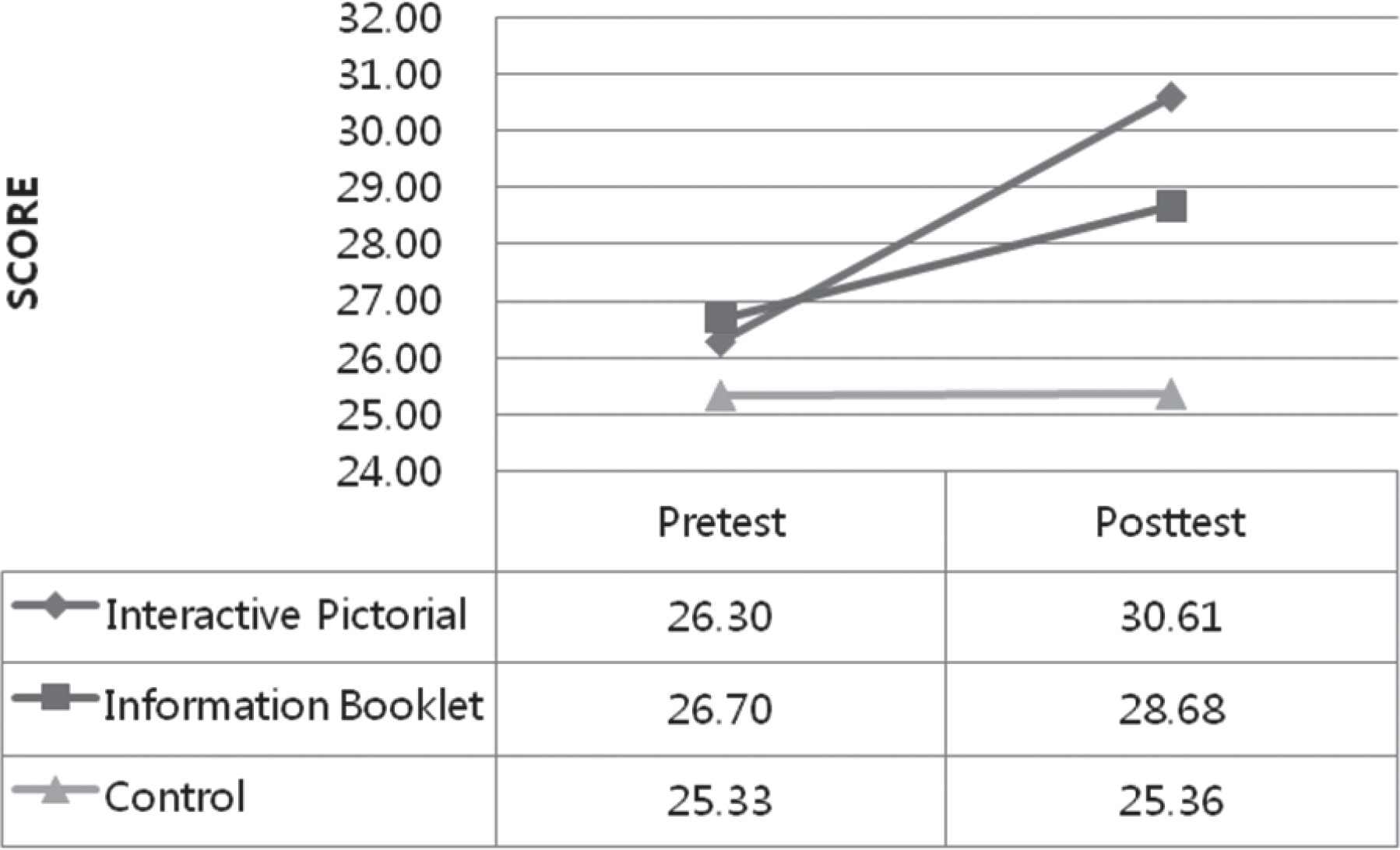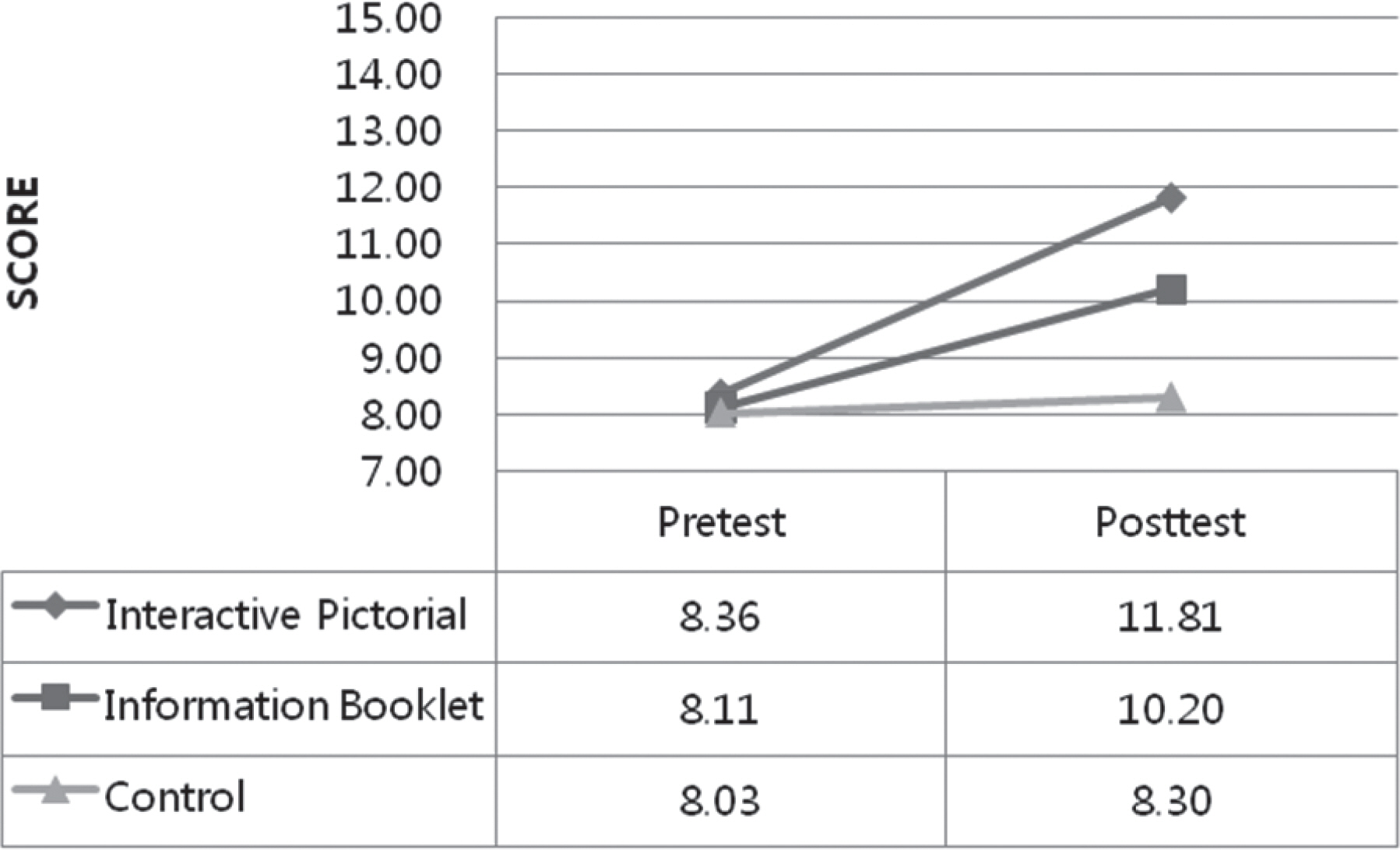J Korean Acad Nurs.
2011 Dec;41(6):795-804. 10.4040/jkan.2011.41.6.795.
Effects of Interactive Pictorial Education on Community Dwelling Older Adult's Self Efficacy and Knowledge for Safe Medication
- Affiliations
-
- 1College of Nursing, Chungnam National University, Daejeon, Korea. mhpark@cnu.ac.kr
- KMID: 1120112
- DOI: http://doi.org/10.4040/jkan.2011.41.6.795
Abstract
- PURPOSE
The purpose of this study was to examine the effects of interactive pictorial education on community dwelling older Korean adults' self-efficacy and knowledge for safe medication.
METHODS
A quasi-experimental, three-group pre- and post-intervention design was used in this study. The interactive pictorial education was designed to suit the learning patterns and psychomotor skills of older adults. The education content, dealing with safe medication, was delivered over three sessions. A total of 136 older adults from local senior centers were assigned to one of the three groups: a) interactive pictorial education plus information booklet (experimental); b) education only with information booklet (conventional); or c) no intervention (control).
RESULTS
Participants receiving interactive pictorial education had significantly higher self-efficacy (F=24.32, p<.001) and knowledge (F=24.26, p<.001) scores than the information booklet or control group at post intervention. Post-hoc analyses indicated that both the interactive pictorial and the information booklet groups had significantly higher self-efficacy and knowledge scores than the control group at the post-test point (p<.05). Furthermore, the interactive pictorial group had higher self-efficacy and knowledge scores than the information booklet group at the post-test point (p<.05).
CONCLUSION
These results suggest that the interactive pictorial education is an innovative approach that provides a means for older adults to learn appropriate medication use to improve their own health. It empowers older adults with different literacy levels to enhance their self-efficacy and knowledge for the safe use of medication.
Keyword
MeSH Terms
Figure
Reference
-
References
Andrus M R &., Roth M T. 2002. Health literacy: A review. Pharmacotherapy. 22:282–302. doi: 10.1592/phco.22.5.282.33191.
ArticleBandura A. 1986. Social foundations of thought and action: A social cognitive theory. 2nd ed.Englewood Cliffs, NJ: Prentice Hall.Bloom B. 1956. Taxonomy of educational objectives, hand-book 1: Cognitive domain. Longman, NY: David McKay.Cohen J. 1988. Statistical power analysis for behavioral sciences. Hillsdale, NJ: Lawrence Erlbaum Associates Inc..DiMatteo M R. 2004. Variations in patients’ adherence to medical recommendations: A quantitative review of 50 years of research. Medical Care. 42:200–209. doi: 10.1097/01.mlr.0000114908.90348.f9.Dowse R &., Ehlers M. 2005. Medicine labels incorporating pictograms: Do they influence understanding and adherence? Patient Education and Counseling. 58:63–70. doi:10.1016/j.pec.2004.06.012.
ArticleFialova D., Topinkova E., Gambassi G., Schroll M., Onder G., Sorbye L W. . 2005. Potentially inappropriate medication use among elderly home care patients in Europe. Te Journal of the American Medical Association. 293:1348–1358. doi: 10.1001/jama.293.11.1348.Grant J &., Davis L. 1997. Selection and use of content experts for instrument development. Research in Nursing and Health. 20:269–274. doi: 10.1002/(SICI)1098-240X(199706)20:3<269::AID-NUR9>3.0.CO;2-G.
ArticleHan K S., Moon S Y., Park H O &., Park E H. 2000. The survey on the drug use status, knowledge and attitude of college students -Seoul and northern part of the Kyunggi-do. Te Journal of Korean Academic Society of Nursing Education. 6:376–389.Han J H. 2007. Te infuence of cognitive function, their family support and medication knowledge upon medication adherence in old people. Unpublished master’s thesis, Ewha Womans University, Seoul.Hill L H. 2004. Concept mapping in a pharmacy communications course to encourage meaningful student learning. American Journal of Pharmaceutical Education. 68:109.
ArticleHouts P S., Doak C C., Doak L G &., Loscalzo M J. 2006. The role of pictures in improving health communication: A review of research on attention, comprehension, recall, and adherence. Patient Education and Counseling. 61:176–190.
ArticleKatz M Z., Kripalani S &., Weiss B D. 2006. Use of pictorial aids in medication instructions: A review of the literature. American Journal of Health System Pharmacy. 63:2391–2397. doi:10.2146/ajhp060162.
ArticleKripalani S., Robertson R., Love-Ghaffari M A., Henderson L E., Praska J., Strawder A. . 2007. Development of an illustrated medication schedule as a low-literacy patient education tool. Patient Education and Counseling. 66:368–377. doi:10.1016/j.pec.2007.01.020.
ArticleLee S &., Park M. 2010. A study on health literacy, medication knowledge, and medication misuse of rural elderly. Journal of the Korean Gerontological Society. 30:485–497.Lee J H &., Park M H. 2007. The effects of an education program for safe drug use in the rural elderly. Journal of Korean Academy of Nursing. 37:295–304.
ArticleLee T H &., Kang S J. 2008. Actual condition and influence of Korean elderly health literacy. Journal of the Korean Gerontological Society. 28:847–863.Lin C A., Neafsey P J &., Strickler Z. 2009. Usability testing by older adults of a computer-mediated health communication program. Journal of Health Communication. 14:102–118. doi: 10.1080/10810730802659095.
ArticleMansoor L E &., Dowse R. 2004. Design and evaluation of a new pharmaceutical pictogram sequence to convey medicine usage. Ergonomics Society of South America. 2:29–41.Ministry of Health and Welfare. 2009. 2008 Korean elderly survey. Seoul: The Author.Molassiotis A., Nahas-Lopez V., Chung W Y., Lam S W., Li C K &., Lau T F. 2002. Factors associated with adherence to antiretroviral medication in HIV-infected patients. International Journal of STD & AIDS. 13:301–310. doi: 10.1258/0956462021925117.Neafsey P J., Strickler Z., Shellman J &., Padula A T. 2001. Delivering health information about self-medication to older adults. Journal of Gerontological Nursing. 27(11):19–27.
ArticleNeafsey P J., Anderson E., Coleman C., Lin C A., M’lan C E &., Walsh S. 2009. Reducing adverse self-medication behaviors in older adults with the next generation personal education program: Design and methodology. Journal of Patient Preference and Adherence. 6:323–334. doi: 10.1007/s12126-010-9085-9.Owen S V. 1993. Professor test scoring manual (revised). Storrs, CT: Bureau of Educational Research and Service. University of Connecticut.Park M S. 2008. Drug use in the elderly. Journal of Korean Academy of Nursing. 15:195–205.Risser J., Jacobson T A &., Kripalani S. 2007. Development and psychometric evaluation of the self-efficacy for appropriate medication use scale (SEAMS) in low-literacy patients with chronic disease. Journal of Nursing Measurement. 15:203–219. doi: 10.1891/106137407783095757.
ArticleSawhney B B &., Reicherter E A. 2005. Literacy and the older adult: Educational considerations for health professionals. Topics in Geriatric Rehabilitation. 21:275–281.Scherer Y K &., Bruce S. 2001. Knowledge, attitudes, and self-efficacy and compliance with medical regimen, number of emergency department visits, and hospitalizations in adults with asthma. Heart & Lung: Te Journal of Acute and Critical Care. 30:250–257. doi: 10.1067/mhl.2001.116013.
ArticleShin K R., Kim J S., Kim J Y &., Yi H R. 2005. Effects of a drug misuse and abuse prevention program on knowledge, attitude, and preventive behaviors related to drug misuse and abuse, and depression in low-in-come elderly women. Journal of Korean Academy of Nursing. 35:763–773.
ArticleSojourner R J &., Wogalter M S. 1998. The influence of pictorials on the comprehension and recall of pharmaceutical safety and warning information. International Journal of Cognitive Ergonomics. 2:93–106.Wilson F L., Mood D &., Nordstrom C K. 2010. The influence of easy-to-read pamphlets about self-care management of radiation side effects on patients’ knowledge. Oncology Nursing Forum. 37:774–781. doi: 10.1188/10.ONF.774-781.
Article
- Full Text Links
- Actions
-
Cited
- CITED
-
- Close
- Share
- Similar articles
-
- Development and Evaluation of a Computerized Multimedia Approach to Educate Older Adults about Safe Medication
- A Structural Equation Model of Fall Prevention Behavior among Community-dwelling Older Adults with Osteoarthritis
- Development of a Knowledge Scale of Fall Risk Factors for Community-dwelling Older Adults
- The Effects of a Dementia Education Program for the Aged
- Relations among Knowledge, Fear and Efficacy of Fall in the Community Dwelling Elderly





